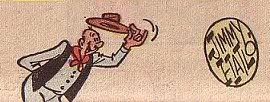Piggybacking Off Peterson and Other Things
Skip to commentsEarlier today Mike Peterson mentioned some events happening in non-Upstate New York. Well, if you are headed to Upstate New York sometime in the next two months you may want stop by the Ellenville Public Library and Museum for R. Robert Pollak‘s “A Cavalcade of American Newspaper Comic Strip Art” exhibit.
It features Pollak’s collection of original pen and ink drawings of classic American comics like “Steve Canyon,” “Dick Tracy,” “Brenda Starr,” “Flash Gordon” and “Joe Palooka.” They’re comics that set Pollak on a path to become a member of the National Cartoonists Society, the creator of his own Shawangunk Journal comic strip, “Ellen’s Adventures at the Shadowland,” the art director for JC Penney, an illustrator for publications like the SoHo Weekly News and the designer of windows at Manhattan’s Saks Fifth Avenue and B Altman & Company.
The Times Herald-Record reviews the show.
And Mike’s mention of the CXC/AAEC convention reminds me that I don’t think we’ve mentioned that there is only a couple weeks for cartoonists to get their entries in for the 2019 Rex Babin Memorial Award for Excellence in Local Cartooning competition.
Here’s some more information about the 2019 CXC.
That’s current cartooning.
Whereas Paul Berge likes to spend Saturdays showing cartoons of 100 years ago.
Which brings us to…
Cartoons Magazine, debuting in 1912, was a monthly magazine devoted primarily to reprinting editorial cartoons from U.S. and foreign newspapers. Articles about cartooning and cartoonists often supplemented the discussion of current events.
In November 1913 the magazine began to offer a monthly round-up of news about cartoonists and cartooning, eventually titled “What The Cartoonist Are Doing.” There are lots of interesting historical nuggets in these sections, and this Stripper’s Guide feature will reprint one issue’s worth each week.
An exciting new Saturday feature of Allan’s Stripper’s Guide, What The Cartoonist Are Doing, will give us the gossip of cartoonists 100 years ago.
For a history of Cartoons Magazine we turn to R. C. Harvey’s
CARTOONS MAGAZINE (May 25, 2019)
A Historic Periodical, 1912-1921
R. C. Harvey‘s site is pay-per-view, except for this month of August during which he has generously offered it up as Open Access Month!
Twenty years of Bob’s historical essays, Harv’s Hindsights, about all things comic (including the May 2019 history of Cartoons Magazine); plus Bob’s twice monthly look at the current comics scene, Rants & Raves, where he offers news and reviews and insights into same:
ABOUT THOSE 2,000 EDITOONISTS
Who Worked in American Newspapers in about 1900
If there were 2,000 editoonists at the beginning of the 20th century, they were not full-time editorial cartoonists. They were “staff artists/cartoonists,” some of whom occasionally drew an editorial cartoon but they mostly drew other stuff—like borders around photographs, f’instance.
So where does the number 2,000 come from?
From the number of newspapers in the country.
Edwin Emery in his definitive history of American newspaper journalism, The Press and America, says that “the years 1910 to 1914 mark the high point in numbers of newspapers published in the United States. The census of 1910 reported 2,600 daily publications of all types, of which 2,200 were English-language newspapers of general circulation.”
That’s where the number comes from. Two thousand two hundred, 2,200.
If a newspaper was financially healthy enough to publish daily, it had resources sufficient for hiring artists—at least one— some of whom could draw cartoons, And some of them did, on occasion, as I just said a paragraph ago. And some of those cartoons, sometimes, were political in intent. (Some were not: some were just funny.)
But to claim that because a newspaper artist occasionally drew an editorial cartoon he/she was an “editorial cartoonist” in the common use of the term today—that’s fudging of the colossal variety.
If doing an occasional editoon qualified an artist as an editorial cartoonist, then we have a whole lot more than a couple dozen editorial cartoonists today.
But that’s not how we’ve been counting. We’ve been counting only full-time staff editorial cartoonists. They have to be full-time, and they have to be on the paper’s payroll and come to work every day and draw the usual health benefits.
Most of those who are doing the counting agree that there are definitely 29 cartoonists who are full-time staff political cartoonists. Then, depending upon various other qualifiers (freelance full-time, enough to make a living at it, on contract but not drawing benefits, etc.), there might be as many as 48.
So for a look at comic strips, editorial cartooning, comic books, magazine cartooning, and more (including insightful behind the scenes information and a twenty year archive) check out R. C. Harvey’s site. Free for August!
Hat tip to the Grand Comics Database for the Cartoons Magazine covers.








Comments 1
Comments are closed.